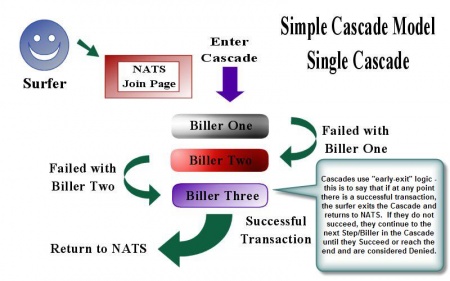Difference between revisions of "NATS Cascades"
m |
TMMStephenY2 (talk | contribs) |
||
| Line 14: | Line 14: | ||
this process: | this process: | ||
| − | [[ | + | [[File:Cascade_model_single.jpg|450 px|Figure 1.1 - Example Cascade Model]] |
Surfers are sent from one biller to the next until they complete a | Surfers are sent from one biller to the next until they complete a | ||
Latest revision as of 11:27, 9 June 2010
NATS 4
|
|---|
NATS 3
|
|---|
What Are Cascades?
Cascades send surfers through multiple billers to increase sign-up probability.
Cascades At A Glance
If a biller denies a surfer transaction, the surfer is sent to the next biller. The diagram, Figure 1.1, provides a simple, graphical representation of this process:
Surfers are sent from one biller to the next until they complete a transaction or the surfer reaches the end of the Cascade. A cascade ends with either of the two special cascade steps: Stop Cascade or Switch Cascade step. For example: a credit card cascade might switch cascade to a check cascade.
Each Cascade has a description attribute, which is displayed to the surfer on the Join Form. Usually this description is "Join by payment type." By selecting a payment type, the surfer transparently selects the Cascade to handle their transaction.
Cascades can also geo-target whole Cascades or individual Cascade steps using the GeoIP program. Geo-targeting sends surfers from one location to a different cascade than surfers from another location.
NATS can also randomly choose the cascade a surfer sees. For example: you can divide your surfers between two billers to test the biller's effectiveness.
